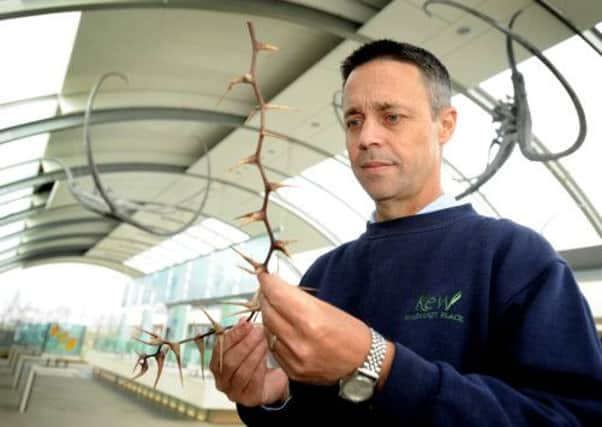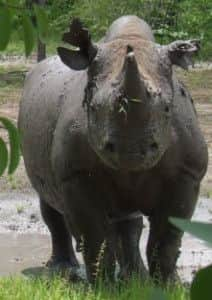Wakehurst’s Paul Smith sows seeds of rhino conservation


In 1855 Livingstone was the first European to follow the Zambezi River to Victoria Falls, the world’s largest waterfall, which he named after his monarch, Queen Victoria.
Dr Smith, on the other hand, was more interested in botany than geography but may also claim to have had a hand in putting land-locked Zambia on the world map if for different reasons.
Advertisement
Hide AdAdvertisement
Hide AdThe intrepid scientist, who is more normally based at the Millennium Seed Bank at Wakehurst Place in Ardingly, has just spent two weeks in Zambia recording the type of vegetation that makes a tasty meal for a black rhino. Some 20 years ago, when black rhinos had been extinct in the country for a decade, he carried out a vegetation survey in the same North Luangwa National Park.


Now rhinos that are being slaughtered by poachers at a rate of one every 14 hours in other parts of Africa, have been reintroduced with 27, including babies, living in the park.
The two-tonne animals have been imported from Krugger National Park in South Africa and are being studied to see how well they are adapting to their new environment including its different plant life.
Dr Smith, who was accompanied at all times by guards armed with AK 47 rifles, carried out his survey by back tracking radio-tagged animals and observing what woody trees and shrubs they had browsed.
Advertisement
Hide AdAdvertisement
Hide AdHe said: “We back-tracked seven rhinos to see what they had eaten and we recorded what was available for them and then we will go back in October and compare with how the situation is in the dry season.”
Black rhinos are now considered critically endangered and the hand-picked armed scouts who work in the national park know each of them individually, spending as they do every day and night guarding them from the threat of poachers.
But getting closer to the animals than a few tens of metres is not an option as rhinos can be very aggressive and dangerous. Their eyesight is poor but their sense of smell is acute and sudden awareness of an intruder in their territory can lead to two-tonnes of animal and sharp horn charging towards you.
Dr Smith said: “We got close to them, as close as we wanted to but, thankfully, they crashed off in the other directions.
Advertisement
Hide AdAdvertisement
Hide Ad“One of the guards showed us a pair of his underpants that had been split from top to bottom by a rhino horn that had missed his skin by millimetres! He was very lucky indeed to still be alive.”
Dr Smith, head of Kew’s internationally-renowned Millennium Seed Bank at Wakehurst, has written a blog on the Kew website about his daily tasks including tracking a male rhino called Kango.
Dr Smith wrote: “We located Kango with the tracking device (he has a radio transmitter collar), but he caught wind of us when we were about 40 yards away. He took off with quite a hullabaloo – fortunately, downwind and away from us. Rhinos are big, heavy animals and the last thing you want is two tonnes of irate rhino coming at you through thick bush.”
Another extract reads: “Up at 5.30 this morning, I flew with Ed across the valley to drop some supplies to game scouts on the other side of the Luangwa river. Beautiful views in the early morning. We saw elephants, zebra, wildebeest, eland and then a pride of 15 lions following a buffalo herd on the Mwaleshi river. Back for breakfast at seven, then out with my companions, the game scouts Chambo and Michael, to do our first rhino browse transect.”
Advertisement
Hide AdAdvertisement
Hide AdThe surveys done by Dr Smith will help the park managers measure the capacity of the vegetation to support the rhinos and to evaluate how many animals can be reintroduced.
He said: “If this seems like a lot of trouble to go to, it is worth remembering that black rhinos are critically endangered. In South Africa alone, it is estimated that a rhino is poached every 14 hours for their horns. According to TRAFFIC, the major market is the far east where the horns are used as a hangover cure amongst other things.”
The life of a roving international botanist is not always smooth, however. In his blog Dr Smith writes: “We sampled around 300 plants on our narrow transect, covering perhaps a couple of kilometres up the riverine catena. We finished at about 11am, and headed back up to the car with Ed Sayer (chief technical adviser in North Luangwa) leading the way, Chambo and Michael behind him and me bringing up the rear. Ed stepped over a Mocambique spitting cobra without noticing it, but Chambo coming second jumped a foot in the air as it raised its head and inflated its hood. We rapidly retreated, and it went on its way. I got a fuzzy photo on full zoom!”
Other hazards included the golden orb spider, measuring an arachnophobia-inducing 10cm across with an accompanying nasty bite!